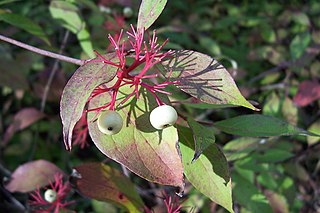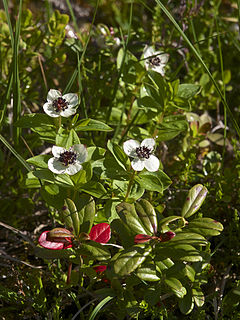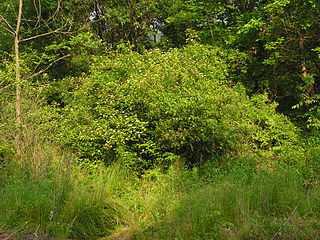
Cornus florida, the flowering dogwood, is a species of flowering tree in the family Cornaceae native to eastern North America and northern Mexico. An endemic population once spanned from southernmost coastal Maine south to northern Florida and west to the Mississippi River. The tree is commonly planted as an ornamental in residential and public areas because of its showy bracts and interesting bark structure.

Cornus is a genus of about 30–60 species of woody plants in the family Cornaceae, commonly known as dogwoods, which can generally be distinguished by their blossoms, berries, and distinctive bark. Most are deciduous trees or shrubs, but a few species are nearly herbaceous perennial subshrubs, and a few of the woody species are evergreen. Several species have small heads of inconspicuous flowers surrounded by an involucre of large, typically white petal-like bracts, while others have more open clusters of petal-bearing flowers. The various species of dogwood are native throughout much of temperate and boreal Eurasia and North America, with China, Japan, and the southeastern United States being particularly rich in native species.

Cornus kousa is a small deciduous tree 8–12 m (26–39 ft) tall, in the flowering plant family Cornaceae. Common names include kousa, kousa dogwood, Chinese dogwood, Korean dogwood, and Japanese dogwood. Synonyms are Benthamia kousa and Cynoxylon kousa. It is a plant native to East Asia including Korea, China and Japan. Widely cultivated as an ornamental, it is naturalized in New York State.

Cornus nuttallii, the Pacific dogwood or mountain dogwood, is a species of dogwood native to western North America from the lowlands of southern British Columbia to the mountains of southern California, with an inland population in central Idaho. Cultivated examples are found as far north as Haida Gwaii. It is a small to medium-sized deciduous tree, reaching 10–25 m tall.

Cornus walteri, also called Walter's dogwood, is a deciduous shrub or small tree 8–16 m tall, native to eastern Asia in Korea and much of China from Liaoning to Yunnan.

Cornus canadensis is a species of flowering plant in the dogwood family, native to eastern Asia, the northern United States, Colorado, New Mexico, Canada and Greenland. Unlike its relatives, which are for the most part substantial trees and shrubs, C. canadensis is a creeping, rhizomatous perennial growing to about 20 cm (8 in) tall.

Cornus racemosa, the northern swamp dogwood, gray dogwood or panicle dogwood, is a shrubby plant native to southeastern Canada and the northeastern United States. It is a member of the dogwood genus Cornus and the family Cornaceae.

Cornus sericea, syn. C. stolonifera, Swida sericea, red osier or red-osier dogwood, is a species of flowering plant in the family Cornaceae, native throughout northern and western North America from Alaska east to Newfoundland, south to Durango and Nuevo León in the west, and Illinois and Virginia in the east. It has sometimes been considered a synonym of the Asian species Cornus alba. Other names include red brush, red willow, redstem dogwood, redtwig dogwood, red-rood, American dogwood, creek dogwood, and western dogwood.

Cornus sanguinea, the common dogwood or bloody dogwood, is a species of dogwood native to most of Europe and western Asia, from England and central Scotland east to the Caspian Sea. It is widely grown as an ornamental plant.

Cornus suecica, the dwarf cornel or bunchberry, is a species of flowering plant in the dogwood family Cornaceae, native to cool temperate and subarctic regions of Europe and Asia, and also locally in extreme northeastern and northwestern North America.

Cornus alba, the red-barked, white or Siberian dogwood, is a species of flowering plant in the family Cornaceae, native to Siberia, northern China and Korea. It is a large deciduous surculose (suckering) shrub that can be grown as a small tree. As a popular ornamental used in landscaping its notable features include the red stems in fall (autumn) through late winter, the brightest winter bark of any cornus; and the variegated foliage in some cultivars, such as C. alba 'Elegantissima', in which the discreet flat whitish flower clusters are almost lost in the variegated texture and dappled light. C. alba can grow to 3 m (10 ft) high, but variegated forms are less vigorous. For the brightest winter bark, young shoots are encouraged by cutting to the ground some older stems at the end of the winter, before leaves are open. The oval fruits are white, sometimes tinted blue.

Cornus amomum, the silky dogwood, is a species of dogwood native to the eastern United States, from Michigan and Vermont south to Alabama and Florida. Other names for this dogwood have included red willow, silky cornel, kinnikinnick, and squawbush.

Cornus drummondii, commonly known as the roughleaf dogwood, is a small deciduous tree that is native primarily to the Great Plains and Midwestern regions of the United States. It is also found around the Mississippi River. It is uncommon in the wild, and is mostly found around forest borders. The roughleaf dogwood is used as a buffer strip around parking lots, in the median of highways and near the decks and patios of homes. It can grow to a height of 15 to 25 feet with a spread of 10 to 15 feet. The roughleaf dogwood flowers during the summer months. It produces near-white four-petaled flowers that are followed by small white fruits, which ripen from August to October. These dogwoods can form a dense thicket that is used as cover for wildlife. Over forty species of birds are known to feed on the fruits.

Cornus officinalis, the Japanese cornel or Japanese cornelian cherry, is a species of flowering plant in the dogwood family Cornaceae. Despite its name it is native to China and Korea as well as Japan. It is not to be confused with C. mas, which is also known as the Cornelian cherry. It is not closely related to the true cherries of the genus Prunus.

Cornus foemina is a species of flowering plant in the Cornaceae known by the common names stiff dogwood and swamp dogwood. It is native to parts of the eastern and southeastern United States.

Cornus hongkongensis is a species of evergreen dogwood native to China, Laos, and Vietnam. It grows to 15 meters in height and blooms in late spring to early summer, exhibiting an abundance of fragrant flowers. Because this species of dogwood also exhibits a range of minor differences in morphology due largely to geographic distribution, it has been divided into a number of subspecies. It has been described as an excellent ornamental tree species.
Cornus obliqua, the blue-fruited dogwood, silky dogwood, or pale dogwood, is a flowering shrub of eastern North America in the dogwood family, Cornaceae. It is sometimes considered a subspecies of Cornus amomum, which is also known as silky dogwood. It was first described in 1820 by Constantine Samuel Rafinesque. It is in the subgenus Kraniopsis.

Cornus elliptica is a species of dogwood found in Fujian, Guangdong, Guangxi, Guizhou, Hubei, Hunan, Jiangxi, Sichuan provinces of China at elevations of 300–2200 meters.

Cornus hemsleyi is a species of dogwood found in Gansu, Guizhou, Hebei, Henan, Hubei, Qinghai, Shaanxi, Shanxi, Sichuan, Xizang, Yunnan provinces of China at elevations of 1000–4000 meters.

Cornus wilsoniana, called ghost dogwood or Wilson's dogwood, is species of Cornus native to central and southeastern China. A tree typically 5 to 10 m, rarely reaching 40 m, it has leaves with white undersides, profuse white flowers in May, and striking grey–green mottled bark on mature specimens. The purplish‑black fruit are harvested for vegetable oil, the leaves are used for fodder, and the timber is valued for tools and furniture. Its well-shaped crown and attractive bark has led to proposals that it be developed as a street tree.



















